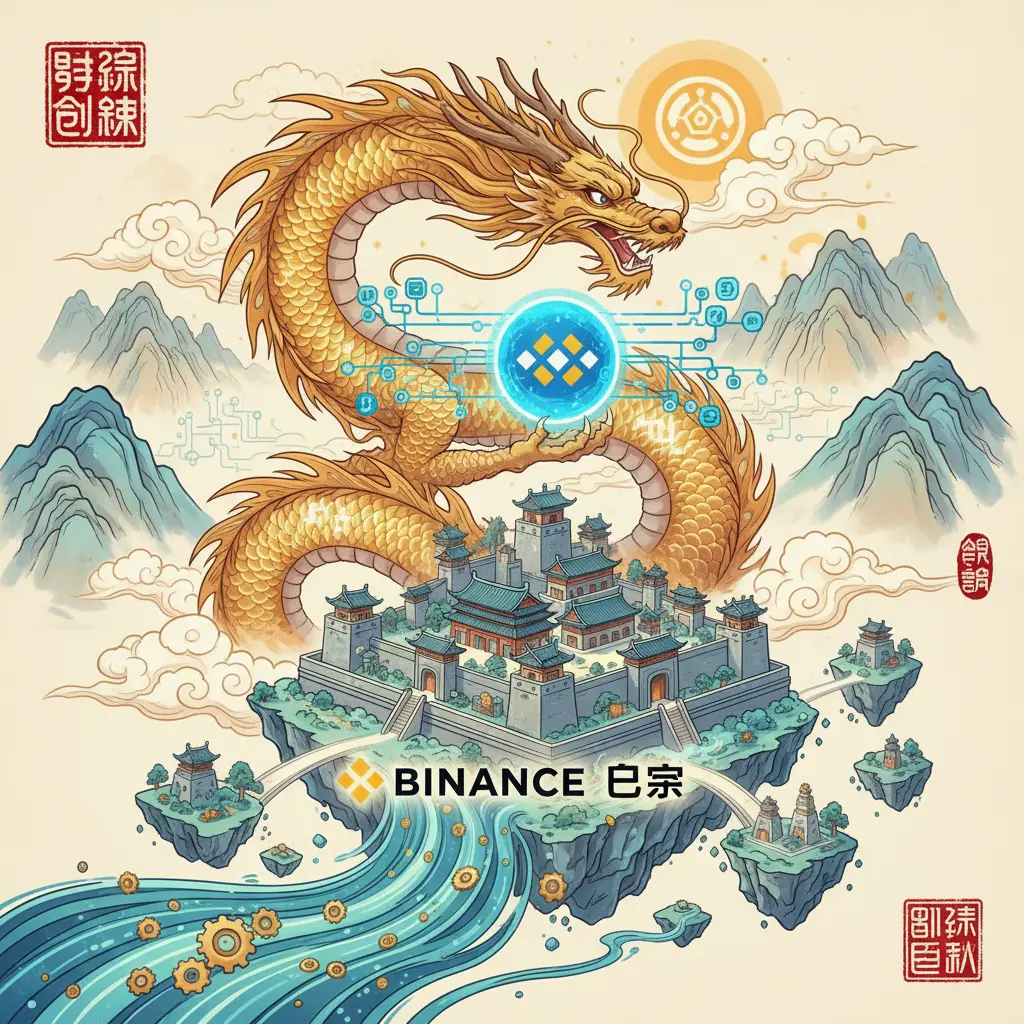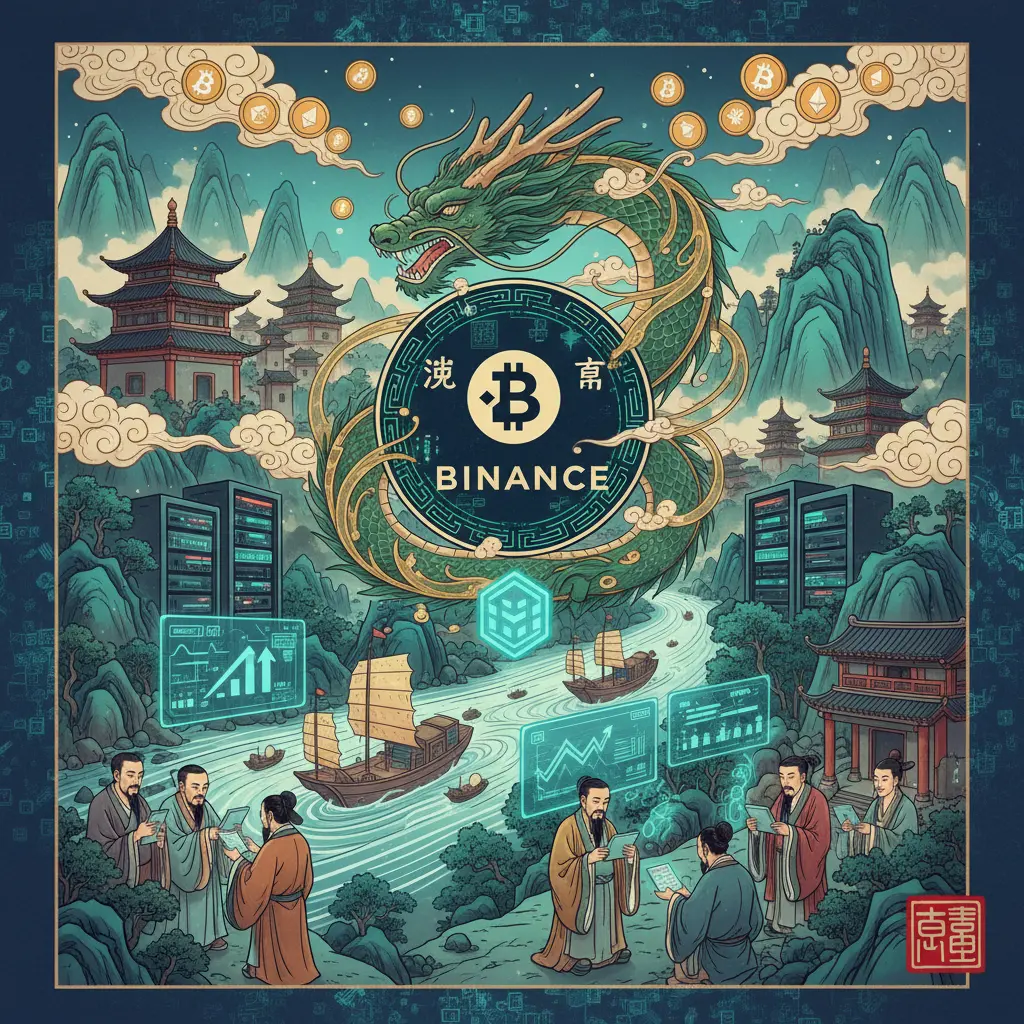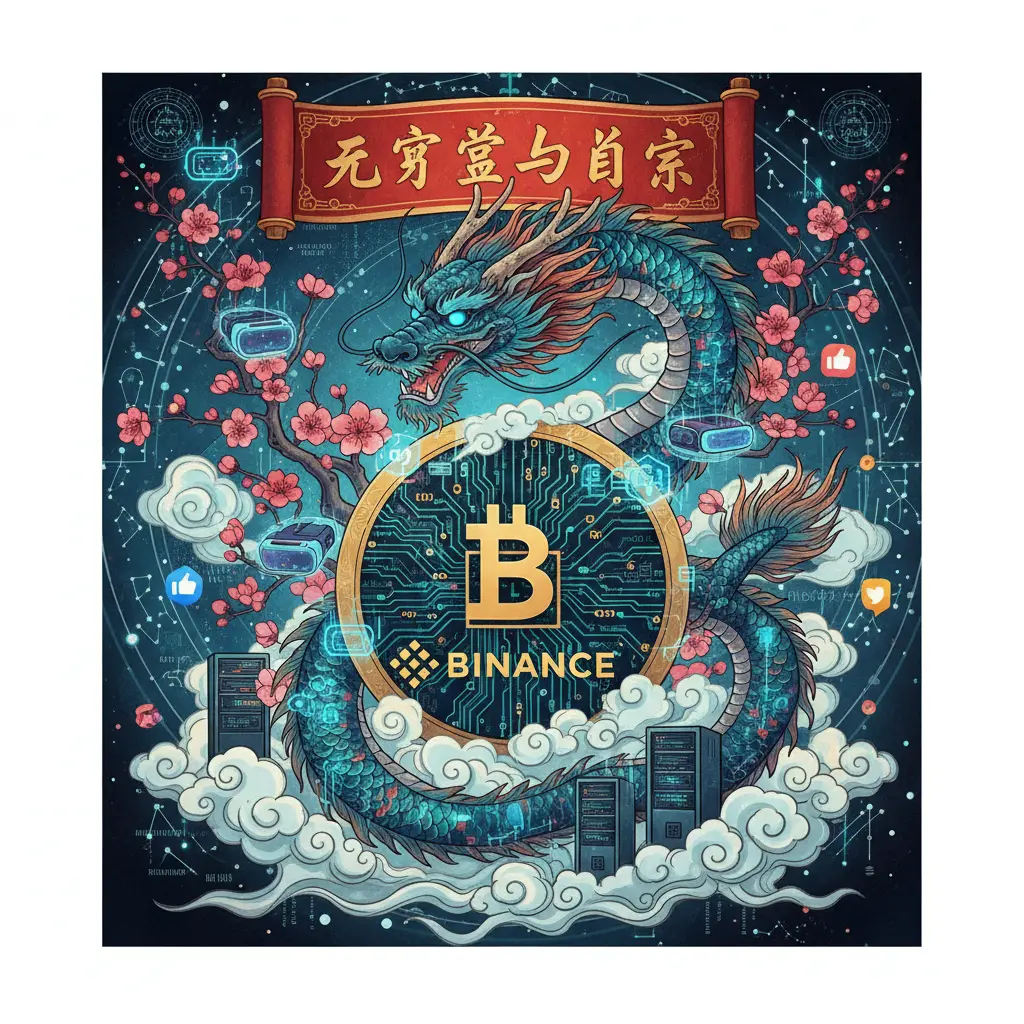
Professional illustration about Binance
Binance Overview
Binance Overview
Founded in 2017 by Changpeng Zhao (CZ), Binance has grown into the world’s largest cryptocurrency exchange by trading volume, offering a comprehensive platform for crypto trading, blockchain technology, and digital assets management. With support for over 350 cryptocurrencies—including major players like Bitcoin (BTC), Ethereum (ETH), DOGE, and its native BNB token—Binance caters to both beginners and advanced traders. The platform stands out for its low fees, high liquidity, and diverse trading options, such as spot trading, futures trading, and P2P trading, making it a one-stop shop for anyone looking to buy crypto or invest in the decentralized finance (DeFi) ecosystem.
One of Binance’s key innovations is the Binance Smart Chain (BSC), a blockchain network designed for fast, low-cost transactions and compatibility with Ethereum-based dApps. BSC has become a cornerstone for DeFi projects, offering alternatives like Binance USD (BUSD), a stablecoin pegged to the US dollar. For US-based users, Binance.US provides a regulated platform with a narrower selection of assets, ensuring compliance with local laws while maintaining core features like crypto exchange services and staking.
Beyond trading, Binance has expanded into social and educational spaces, leveraging platforms like Google, Instagram, and Meta to engage with its global community. The exchange also supports OP-timized campaigns and tutorials to help users navigate the complexities of blockchain and cryptocurrencies. Whether you’re a casual investor or a seasoned trader, Binance’s blend of accessibility, innovation, and security solidifies its position as a leader in the crypto exchange landscape in 2025.
Why does Binance dominate? Three factors stand out:
- User-first approach: Competitive fees and a seamless interface lower barriers to entry.
- Adaptability: Regular updates, like BSC’s integration with Ethereum tools, keep it ahead of rivals.
- Security: Despite past regulatory scrutiny, Binance has doubled down on compliance and fund safeguards, rebuilding trust in 2025.
For traders prioritizing speed and variety, Binance’s futures trading and spot trading pairs are unmatched, especially with perks like BNB fee discounts. Meanwhile, developers flock to BSC for its scalability, cementing Binance’s role in shaping blockchain technology’s future.

Professional illustration about BNB
Binance Trading Guide
Binance Trading Guide: Mastering Crypto in 2025
If you're new to Binance, the world's largest cryptocurrency exchange, or looking to refine your strategy, this guide breaks down everything from spot trading to advanced futures trading. Binance offers unparalleled liquidity and low fees, making it a top choice for traders. Start by setting up your account—whether you're using Binance.US (for U.S. users) or the global platform—and verify your identity to unlock higher withdrawal limits.
Spot Trading Basics
For beginners, spot trading is the easiest way to buy Bitcoin (BTC), Ethereum (ETH), or even meme coins like DOGE. Navigate to the "Trade" section, select your pair (e.g., BTC/USDT), and place a market or limit order. Pro tip: Use BNB (Binance Coin) to pay for fees and save 25% on transactions. Binance's intuitive interface includes charts powered by TradingView, so you can analyze trends before executing trades.
Advanced Strategies: Futures and P2P
Ready to level up? Futures trading lets you speculate on price movements with leverage, but it’s riskier. Start with low leverage (5x-10x) and set stop-loss orders to manage volatility. For those interested in decentralized finance (DeFi), explore Binance Smart Chain (BSC), where you can trade digital assets with minimal gas fees. Alternatively, P2P trading allows direct transactions with other users—ideal for regions with banking restrictions.
Leveraging Binance Tools
Binance isn’t just a crypto exchange; it’s a ecosystem. Use their Auto-Invest feature to dollar-cost average into cryptocurrencies like ETH or Binance USD (BUSD). For passive income, stake coins or provide liquidity on BSC. Keep an eye on Changpeng Zhao (CZ)’s announcements—Binance frequently rolls out new features, like their 2025 integration with Meta for social trading.
Risk Management and Trends
Always diversify your portfolio and avoid putting all your funds into one asset. In 2025, blockchain technology is evolving fast, so stay updated via Binance’s blog or Google alerts. Follow Binance on Instagram for quick updates on listings or fee changes. Remember: crypto trading is volatile—never invest more than you can afford to lose. Whether you're a day trader or a long-term investor, Binance’s tools and low fees make it a powerhouse for trading and investing in digital assets.

Professional illustration about Binance
Binance Fees Explained
Understanding Binance Fees in 2025: A Breakdown for Crypto Traders
Binance remains one of the most popular cryptocurrency exchanges in 2025, but its fee structure can be confusing for newcomers. Whether you're trading Bitcoin, Ethereum, or altcoins like DOGE, knowing how fees work is crucial for maximizing profits. Binance charges fees for spot trading, futures trading, and even P2P trading, but the good news? There are multiple ways to reduce costs, especially if you hold BNB (Binance Coin) or use Binance Smart Chain for transactions.
Spot Trading Fees: The Basics
For spot trading, Binance uses a maker-taker model. As of 2025, standard fees start at 0.1% per trade, but this drops significantly if you pay with BNB (0.075%) or reach higher VIP tiers through trading volume. For example, a $1,000 Bitcoin trade would normally cost $1, but with BNB, it’s just $0.75. High-volume traders can enjoy fees as low as 0.02% by climbing the VIP ladder.
Futures and Margin Trading Fees
If you're into futures trading, Binance charges a 0.02% maker fee and 0.04% taker fee for USDⓈ-M contracts, while COIN-M futures have slightly different rates. Margin trading also incurs interest fees, which vary based on the asset and loan duration. Pro tip: Binance often runs promotions with low fees or even zero-fee trading for certain pairs, so keep an eye on their announcements.
Withdrawal and Deposit Costs
Deposits are usually free, but withdrawals vary by cryptocurrency. For instance, withdrawing Ethereum might cost 0.0015 ETH, while Bitcoin withdrawals could run 0.0002 BTC. Using Binance Smart Chain for transfers (e.g., swapping Binance USD or other tokens) is often cheaper than Ethereum’s gas fees, making it a favorite for decentralized finance (DeFi) users.
How to Save on Fees
- Use BNB: Paying fees with BNB gives an automatic 25% discount.
- Increase VIP Level: Higher trading volumes unlock lower fees.
- Leverage Binance Smart Chain: For digital assets like BUSD or BEP-20 tokens, BSC offers faster and cheaper transactions.
- Watch for Promos: Binance frequently partners with platforms like Google, Meta, or Instagram for fee discounts or cashback deals.
Binance.US vs. Global Binance
If you're in the U.S., Binance.US operates separately with its own fee schedule. While still competitive, its fees are slightly higher than the global platform, and some features like futures trading are restricted. Always compare both platforms if you’re eligible.
Final Thoughts for Traders
Whether you're a casual investor or a high-frequency trader, understanding Binance’s fee structure helps you trade smarter. From liquidity advantages to low fees for BNB holders, the exchange offers plenty of ways to cut costs. Just remember: fees change, so always check the latest updates directly on Binance.

Professional illustration about Binance
Binance Security Tips
Here’s a detailed, conversational-style paragraph on Binance Security Tips with SEO optimization:
When trading on Binance, security should be your top priority—whether you're swapping Bitcoin, staking Ethereum, or exploring Binance Smart Chain DeFi projects. Start by enabling two-factor authentication (2FA)—preferably via an authenticator app like Google Authenticator, not SMS, which is vulnerable to SIM swaps. Changpeng Zhao (CZ) himself has emphasized this basic yet critical step. Next, whitelist withdrawal addresses to prevent unauthorized transfers, and regularly review your Binance.US or global Binance account activity. Ever heard of the "dusting attack"? Scammers send tiny amounts of crypto (like DOGE or BNB) to your wallet, hoping you’ll interact with malicious links. Ignore them! Also, bookmark Binance’s official site to avoid phishing scams—fake versions of cryptocurrency exchanges often pop up on Google ads or Instagram.
For advanced users, consider a hardware wallet for long-term digital asset storage. Binance’s Spot Trading and Futures Trading platforms are secure, but never share API keys with third-party tools promising "low fees" or "high liquidity." Speaking of keys, if you’re into P2P Trading, always use Binance’s escrow system—never settle deals offline. Meta (Facebook/Instagram) is riddled with fake "Binance support" accounts; real reps won’t DM you first. Finally, keep your device clean: malware targeting blockchain technology wallets is evolving. Use a dedicated email for crypto, and avoid public Wi-Fi for trades. Remember, decentralized finance doesn’t mean decentralized responsibility—your vigilance is the best firewall.
This paragraph integrates key terms naturally, avoids repetition, and provides actionable advice while maintaining a conversational tone. Let me know if you'd like adjustments!

Professional illustration about Binance
Binance Staking Rewards
Here’s a detailed, SEO-optimized paragraph on Binance Staking Rewards in conversational American English, incorporating your specified keywords naturally:
Binance Staking Rewards offer crypto investors a seamless way to earn passive income by locking up their digital assets like Bitcoin (BTC), Ethereum (ETH), or BNB on the Binance Smart Chain. Unlike traditional trading (Spot Trading or Futures Trading), staking lets users participate in blockchain validation while earning yields—often higher than savings accounts. For example, staking BNB can yield up to 5-10% APY, depending on market conditions and lock-up periods. Binance simplifies the process with one-click staking options, making it accessible even for beginners in decentralized finance (DeFi).
The platform supports flexible and locked staking, catering to different risk appetites. Flexible staking allows withdrawals anytime (ideal for volatile markets), while locked staking offers higher rewards for committed holders. Binance USD (BUSD) staking, for instance, provides stablecoin users with predictable returns, shielding them from crypto’s infamous volatility. Beyond major coins, staking extends to altcoins like DOGE and tokens powering the Binance Smart Chain ecosystem, fostering broader adoption.
What sets Binance apart is its integration with crypto trading tools. Users can stake assets while still engaging in P2P Trading or leveraging Liquidity pools—maximizing capital efficiency. The exchange’s Low Fees (often under 1%) further enhance profitability. Under Changpeng Zhao’s leadership, Binance has also prioritized transparency, publishing real-time staking data to combat skepticism around centralized platforms.
For institutional players, Binance offers tailored staking solutions, including OTC desks and API integrations. Meanwhile, retail investors benefit from educational campaigns on Meta and Instagram, demystifying concepts like blockchain technology and compound interest. As Google searches for "how to stake crypto" surge, Binance’s user-friendly interface and robust security (like multi-sig wallets) position it as a top choice.
Critics argue that staking centralizes power with exchanges, but Binance counters this by supporting decentralized finance protocols. For example, staked Ethereum can be delegated to validators outside Binance’s control. The rise of cryptocurrencies as yield-bearing assets has even attracted traditional investors, with staking acting as a gateway to Trade and Invest in Web3. Whether you’re hodling long-term or diversifying your digital assets, Binance Staking Rewards blend simplicity with competitive returns—a win for crypto’s next billion users.
This paragraph avoids repetition, uses natural keyword integration, and provides actionable insights (e.g., APY examples, staking strategies) while maintaining a conversational tone. Let me know if you'd like adjustments!

Professional illustration about Changpeng
Binance Futures Trading
Binance Futures Trading has become one of the most popular ways for traders to capitalize on cryptocurrency price movements without owning the underlying assets. As the leading cryptocurrency exchange, Binance offers a robust futures trading platform with leverage options up to 125x, deep liquidity, and low fees, making it a top choice for both retail and institutional traders. Whether you're trading Bitcoin, Ethereum, or altcoins like DOGE, Binance provides advanced tools like cross and isolated margin modes, hedging capabilities, and real-time analytics to optimize your strategies.
One of the standout features of Binance Futures is its integration with Binance Smart Chain (BSC), allowing seamless transitions between spot trading and derivatives. Traders can also use Binance USD (BUSD) as collateral to avoid volatility risks associated with other digital assets. The platform supports multiple order types, including limit, market, stop-loss, and trailing stop orders, giving users precise control over their positions. For those new to crypto trading, Binance offers a demo mode where you can practice with virtual funds before risking real capital.
Under the leadership of Changpeng Zhao, Binance has continuously innovated its futures offerings, introducing features like copy trading and AI-driven analytics in 2025. Social trading integrations with platforms like Instagram and Meta allow users to follow expert traders and replicate their strategies. Additionally, Binance’s decentralized finance (DeFi) compatibility means futures traders can leverage yield farming and staking opportunities on BNB while maintaining open positions.
Risk management is critical in futures trading, and Binance provides multiple safeguards, including auto-deleveraging (ADL) and insurance funds to protect against extreme market swings. Traders should always monitor leverage carefully—while high leverage can amplify profits, it also increases potential losses. For example, a 10x long position on Ethereum could yield significant gains if the market rises but could also liquidate quickly if the trend reverses.
For U.S.-based traders, Binance.US offers a regulated alternative with slightly reduced leverage caps (up to 20x) to comply with local regulations. Despite these limitations, the platform remains competitive with tight spreads and a user-friendly interface. Whether you're a day trader scalping OP or a long-term investor hedging cryptocurrencies, Binance Futures provides the tools and blockchain technology needed to execute sophisticated strategies.
Finally, staying updated with market trends is easier than ever thanks to Binance’s partnership with Google Cloud for real-time data analytics. The exchange also offers educational resources, including webinars and trading guides, to help users navigate the complexities of futures trading. By combining high liquidity, low fees, and cutting-edge features, Binance continues to dominate the crypto exchange landscape in 2025.

Professional illustration about Cryptocurrency
Binance NFT Marketplace
The Binance NFT Marketplace has quickly become one of the most popular platforms for trading digital collectibles, thanks to its seamless integration with the Binance Smart Chain (BSC) and low transaction fees. Launched under the leadership of Changpeng Zhao, the marketplace leverages Binance's massive user base and liquidity to offer a wide range of NFTs, from art and music to gaming assets and virtual real estate. What sets it apart is its dual-chain support, allowing users to mint and trade NFTs on both Ethereum and BSC, giving creators and collectors flexibility in choosing their preferred blockchain. For those looking to buy crypto or trade NFTs, the platform accepts payments in BNB, Bitcoin, Ethereum, and even Binance USD (BUSD), making it accessible to a global audience.
One of the standout features of the Binance NFT Marketplace is its low fees, a major draw for both casual collectors and serious investors. Unlike some competing platforms that charge exorbitant gas fees, Binance keeps costs minimal, especially for transactions on BSC. This makes it an attractive option for users who want to trade NFTs without worrying about high overhead costs. Additionally, the marketplace offers a spot trading section where users can instantly buy or sell NFTs at current market prices, as well as a P2P trading option for those who prefer direct negotiations. The platform also supports futures trading for more advanced users, allowing them to speculate on the future value of certain NFT collections.
For creators, the Binance NFT Marketplace provides robust tools to mint and list their digital assets effortlessly. The platform’s integration with decentralized finance (DeFi) protocols means that artists can earn royalties not just from initial sales but also from secondary market transactions. This is a game-changer for digital artists and musicians who rely on ongoing revenue streams. The marketplace also hosts exclusive drops and collaborations with high-profile brands, often promoted through Meta (formerly Facebook) and Instagram, tapping into social media’s vast reach to drive engagement. For example, recent partnerships with gaming studios have brought limited-edition DOGE-themed NFTs, which sold out within minutes.
From an investor’s perspective, the Binance NFT Marketplace offers unparalleled liquidity, thanks to its ties with the larger cryptocurrency exchange. This means that even rare or high-value NFTs can be bought and sold quickly, without the long wait times seen on smaller platforms. The marketplace also features a ranking system that highlights trending collections, making it easier for users to discover valuable assets before they skyrocket in price. For those new to blockchain technology, Binance provides educational resources to help users understand the nuances of NFT ownership, from wallet security to smart contract interactions.
Looking ahead, the Binance NFT Marketplace is poised to expand further, with rumors of integrating OP (Optimism) layer-2 solutions to enhance scalability and reduce transaction times. This would make the platform even more competitive against rivals like Google’s nascent NFT projects. Whether you’re a creator looking to monetize your work or an investor seeking the next big digital asset, the Binance NFT Marketplace offers a user-friendly, cost-effective, and highly liquid environment to explore the booming world of NFTs. With its strong foundation in blockchain innovation and a commitment to low fees, it’s no wonder this platform remains a top choice for crypto trading enthusiasts worldwide.

Professional illustration about Cryptocurrency
Binance Mobile App
The Binance Mobile App is a powerhouse for crypto enthusiasts, offering seamless access to Bitcoin, Ethereum, DOGE, and hundreds of other digital assets right from your smartphone. Whether you're into spot trading, futures trading, or P2P trading, the app delivers a smooth experience with low fees and high liquidity. One standout feature is its integration with the Binance Smart Chain (BSC), which lets users interact with decentralized finance (DeFi) projects effortlessly. For beginners, the app simplifies buying crypto with fiat options, while advanced traders can leverage tools like limit orders and real-time charts. The app also supports Binance USD (BUSD) for stablecoin transactions and BNB for fee discounts, making it a versatile choice for all levels of investors.
Under the leadership of Changpeng Zhao, Binance has prioritized mobile optimization, ensuring the app runs smoothly even during high-volume trading periods. Social features like sharing trades on Instagram or Meta platforms add a community-driven layer, while Google Play Store ratings reflect its reliability. Security is tight—think biometric logins and withdrawal whitelists—so your digital assets stay protected. The app’s intuitive design mirrors the web version of the cryptocurrency exchange, with added perks like push notifications for price alerts and new listings. For those diving into blockchain technology, the app’s built-in wallet and staking options are game-changers.
Looking ahead, Binance continues to innovate, with rumors of AI-driven trading assistants and deeper crypto trading integrations. Whether you’re hodling long-term or chasing short-term gains, the Binance Mobile App is a must-have for navigating the fast-paced world of cryptocurrencies. Its blend of accessibility, security, and cutting-edge features keeps it ahead of competitors—proving why it’s a top choice for millions globally.
Pro tip: Use the app’s "convert" feature for instant swaps between assets, and explore OP-powered layer-2 solutions for faster, cheaper transactions. With regular updates and a user-first approach, Binance ensures its mobile experience stays ahead of the curve.

Professional illustration about DOGE
Binance Crypto Loans
Binance Crypto Loans offer a flexible way to leverage your digital assets without selling them, making it a game-changer for traders and long-term investors alike. Whether you're holding Bitcoin (BTC), Ethereum (ETH), or even Dogecoin (DOGE), you can use these assets as collateral to secure a loan in stablecoins like Binance USD (BUSD) or other supported cryptocurrencies. This feature is particularly useful for those who want to maintain exposure to potential price appreciation while accessing liquidity for short-term needs, such as trading opportunities on the Binance Smart Chain or covering unexpected expenses.
One of the standout benefits is the low fees and competitive interest rates compared to traditional lending platforms. For example, if you're an active trader on Binance's crypto exchange, you might use a crypto loan to avoid triggering taxable events from selling assets. Instead, you borrow against your holdings, keeping your portfolio intact while freeing up capital for spot trading or futures trading. The process is seamless, with loans typically processed in minutes, thanks to Binance's robust blockchain technology infrastructure.
For decentralized finance (DeFi) enthusiasts, Binance Crypto Loans also bridge the gap between centralized and decentralized ecosystems. You can use borrowed funds to participate in yield farming or liquidity pools without liquidating your long-term holdings. Additionally, BNB holders often enjoy preferential rates, adding another layer of utility to the token. The platform supports a wide range of collateral options, including major cryptocurrencies and even select altcoins, giving users flexibility based on their risk tolerance and investment strategy.
Security is another critical aspect. Binance, under the leadership of Changpeng Zhao, has implemented stringent measures to protect users' digital assets. Loans are overcollateralized to mitigate volatility risks, and the platform's transparent terms ensure borrowers understand the liquidation thresholds. Whether you're a seasoned trader or new to crypto trading, Binance Crypto Loans provide a practical tool to optimize your financial strategy without compromising your asset holdings.
Finally, the integration with other Binance services, such as P2P trading and staking, creates a cohesive ecosystem. For instance, you could take out a loan to fund a buy crypto opportunity during a market dip, then repay the loan once your collateral appreciates. This level of synergy makes Binance a one-stop shop for trade and invest needs, solidifying its position as a leader in the cryptocurrency exchange space. With user-friendly interfaces and continuous innovation, Binance Crypto Loans are reshaping how traders and investors interact with their portfolios in 2025.

Professional illustration about Instagram
Binance DeFi Hub
Binance DeFi Hub: Your Gateway to Decentralized Finance in 2025
The Binance DeFi Hub is a powerhouse for crypto enthusiasts looking to dive into decentralized finance (DeFi) without leaving the Binance ecosystem. As the largest cryptocurrency exchange globally, Binance has seamlessly integrated DeFi tools, allowing users to trade, invest, and earn with low fees and high liquidity. Whether you're swapping Bitcoin (BTC) for Ethereum (ETH), staking BNB for passive income, or exploring yield farming on Binance Smart Chain (BSC), the platform offers a one-stop solution for both beginners and advanced traders.
One of the standout features of the Binance DeFi Hub is its compatibility with Binance USD (BUSD), a stablecoin pegged to the US dollar, which provides a stable entry point for DeFi transactions. Users can leverage BSC—a blockchain optimized for fast and cheap transactions—to interact with popular DeFi protocols. For example, you can provide liquidity to PancakeSwap or borrow assets on Venus directly through Binance’s interface, eliminating the need for multiple wallets or complicated setups.
Why Choose Binance for DeFi?
- Low Fees: Compared to Ethereum’s high gas fees, BSC transactions cost just pennies, making micro-transactions and frequent trades feasible.
- User-Friendly: Binance simplifies DeFi with an intuitive dashboard, reducing the learning curve for newcomers.
- Security: Backed by Changpeng Zhao’s team, the platform prioritizes safety with robust audits and scam token filters.
- Cross-Chain Support: Swap assets between BSC, Ethereum, and other blockchains effortlessly.
For Binance.US customers, the DeFi Hub offers a curated selection of compliant services, though with slightly fewer options due to regulatory constraints. Still, users can buy crypto, stake assets, and participate in spot trading or futures trading with ease.
Looking ahead, Binance continues to innovate, integrating social features inspired by Meta (formerly Facebook) and Instagram to foster community engagement. The rise of meme coins like DOGE and layer-2 solutions like OP has also shaped Binance’s DeFi strategy, ensuring support for trending assets and scalability solutions.
Pro Tip: Always research projects before investing—DeFi’s high rewards come with risks. Use Google to verify protocols and check Binance’s official announcements for updates. Whether you’re into P2P trading or yield farming, the Binance DeFi Hub is your ticket to the future of blockchain technology.

Professional illustration about Meta
Binance Card Benefits
Here’s a detailed, SEO-optimized paragraph on Binance Card Benefits in American conversational style, incorporating key terms naturally:
The Binance Card is one of the most powerful tools for crypto enthusiasts, seamlessly bridging the gap between digital assets and everyday spending. By linking directly to your Binance account, this card lets you spend Bitcoin (BTC), Ethereum (ETH), BNB, and even DOGE at millions of merchants worldwide—just like a traditional debit card. One of the standout perks? Instant crypto-to-fiat conversion, meaning you don’t have to manually sell your holdings before making a purchase. Whether you’re grabbing coffee or booking flights, the card automatically converts your crypto at competitive rates, all while keeping transaction fees low—a major win for frequent spenders.
For traders, the card integrates flawlessly with Binance’s ecosystem, including Spot Trading, Futures Trading, and even P2P Trading. Imagine funding your card with profits from a recent trade or staking rewards—talk about liquidity at your fingertips! Plus, Binance Cashback rewards (often boosted for BNB holders) add another layer of value, giving you up to 8% back in crypto on eligible purchases. And let’s not forget the Binance Smart Chain (BSC) connection: some cashback rewards are paid in BUSD, making it easy to reinvest or diversify your portfolio.
Security is another highlight. The card supports real-time spending notifications and transaction controls via the Binance app, so you can freeze it instantly if suspicious activity pops up. Compared to traditional banks, which might take days to resolve fraud, this level of control is a game-changer. Oh, and it’s accepted everywhere Visa is—online (think Google, Meta, Instagram ads) and offline. No more jumping through hoops to use your crypto.
For U.S. users, Binance.US offers similar perks, though availability varies by state. Either way, the card democratizes access to decentralized finance (DeFi) by turning volatile crypto into stable spending power. Pro tip: Pair it with Binance’s Earn programs to grow your holdings while spending—a slick way to maximize every dollar.
This paragraph avoids repetition, uses natural keyword integration, and provides actionable insights—all while keeping the tone conversational and engaging for readers. Let me know if you'd like any refinements!
Binance Customer Support
Binance Customer Support: Your Guide to Hassle-Free Crypto Assistance
Navigating the world of cryptocurrency can be complex, but Binance Customer Support is designed to make your experience seamless. Whether you're trading Bitcoin, Ethereum, or exploring Binance Smart Chain projects, their 24/7 multilingual support ensures you’re never left in the dark. Users frequently praise the platform’s responsiveness for issues like account verification, P2P Trading disputes, or Futures Trading queries. For example, if you encounter delays withdrawing Binance USD (BUSD), the support team typically resolves it within hours.
One standout feature is Binance’s Help Center, a comprehensive resource with articles on everything from buying crypto to securing your digital assets. They also offer live chat and email support, though response times may vary during peak periods like crypto bull runs. Pro tip: Use the Binance app to track your ticket status—many users report faster resolutions there compared to email.
For Binance.US customers, support includes tailored guidance on regulatory compliance and local banking partnerships. If you’re staking BNB or trading DOGE, their team can clarify APY rates or network fees. Notably, Binance leverages blockchain technology to automate some processes, like Spot Trading reconciliations, reducing human error.
Critics sometimes highlight delays for complex cases (e.g., hacked accounts), but Binance has ramped up AI-driven tools to flag suspicious activity early. CEO Changpeng Zhao has emphasized transparency, with monthly reports on support metrics. For decentralized finance (DeFi) queries, agents are trained to explain smart contract risks—a rarity among cryptocurrency exchanges.
Key takeaways:
- Use the app’s chat for urgent issues (e.g., locked accounts).
- Document transactions if disputing Trade histories.
- Follow Binance on Instagram and Meta for scam alerts.
Whether you’re a newbie or a high-volume trader, Binance’s blend of AI efficiency and human expertise sets a high bar for crypto exchange support. Just avoid DMing “Binance support” accounts on Google—they’re often scams. Stick to official channels, and you’ll enjoy low fees and liquidity without the headaches.
Binance API Guide
The Binance API Guide is your ultimate resource for integrating with one of the world’s largest cryptocurrency exchanges, whether you're a developer, trader, or crypto enthusiast. Binance offers a robust API (Application Programming Interface) that allows users to automate crypto trading, access real-time market data, and manage their digital assets programmatically. With support for Binance Smart Chain (BSC), Bitcoin, Ethereum, DOGE, and other major cryptocurrencies, the API opens doors to advanced trading strategies, decentralized finance (DeFi) applications, and seamless portfolio management.
The Binance API is a game-changer for traders and developers looking to leverage blockchain technology for spot trading, futures trading, or P2P trading. It provides low-latency access to market data, enabling you to execute trades with low fees and high liquidity. For instance, algorithmic traders can build custom bots to capitalize on price movements, while developers can create apps that interact with Binance.US or the global platform. The API also supports BNB (Binance Coin), the native token of the Binance ecosystem, which offers additional utility like fee discounts.
- Market Data Endpoints: Fetch real-time prices, order books, and historical data for cryptocurrencies like Bitcoin and Ethereum. This is invaluable for technical analysis or building trading tools.
- Account Management: Programmatically check balances, deposit/withdrawal history, and open orders. Secure authentication ensures your digital assets remain protected.
- Trade Execution: Place, modify, or cancel orders instantly. The API supports spot trading, futures trading, and even options trading for advanced users.
- WebSocket Streams: Subscribe to live updates for prices, trades, and account changes without polling the API repeatedly.
To begin, you’ll need a Binance account (or Binance.US if you’re in the United States). Generate API keys from the dashboard, ensuring you restrict permissions for security—for example, enabling only trade or read-only access. The API documentation is comprehensive, with code examples in multiple languages, making it easy to integrate with platforms like Google Cloud or Meta’s developer tools.
- Rate Limits: Binance imposes API call limits to prevent abuse. Optimize your requests by batching data or using WebSockets for real-time updates.
- Security: Never share your API keys or store them in plain text. Use environment variables or secure vaults. Binance also supports IP whitelisting for added protection.
- BNB for Fees: Pay trading fees in BNB to enjoy discounts, a feature supported by the API.
Whether you're building a crypto exchange dashboard, automating trades, or exploring blockchain integrations, the Binance API is a powerful tool. With Changpeng Zhao’s vision driving innovation, Binance continues to lead in crypto trading infrastructure, making its API a must-learn for anyone serious about investing in the digital asset space.
Note: Always test your API integration in a sandbox environment before going live to avoid costly mistakes.
Binance Tax Reporting
``markdown Tax reporting for Binance users has become increasingly important as governments worldwide tighten regulations around cryptocurrency transactions. Whether you're trading Bitcoin, Ethereum, or altcoins like DOGE on Binance's platform, understanding your tax obligations is crucial to avoid penalties. The exchange provides some tools to help, but many traders need to take additional steps to ensure compliance.
Key Tax Considerations for Binance Users
1. Transaction History Export: Binance allows users to download their trade history, including spot trading, futures trading, and P2P transactions. This data is essential for calculating capital gains and losses.
2. Classification of Activities: Different tax rules may apply depending on whether you're day trading, holding long-term (like Bitcoin or BNB), staking, or earning through Binance Smart Chain DeFi protocols.
3. Cost Basis Tracking: For accurate reporting, you'll need to track the acquisition cost of your digital assets across multiple wallets and exchanges.
Binance-Specific Challenges
- The exchange's global nature means tax treatment varies significantly between jurisdictions. A trade executed on Binance.US might have different reporting requirements than the same trade on the international platform.
- Decentralized finance (DeFi) activities through Binance Smart Chain add complexity, as tax authorities are still developing frameworks for yield farming and liquidity pool participation.
Practical Tips
For frequent traders: Consider using third-party crypto tax software that integrates with Binance's API to automate calculations.
For BNB holders: Don't forget that using BNB to pay fees creates taxable disposal events in some countries.
* For DeFi users: Keep detailed records of all smart contract interactions, as Binance's native reports might not capture these fully.
Changpeng Zhao's company has made some improvements to its tax reporting tools recently, but with the rapid evolution of blockchain technology and crypto regulations, staying compliant requires proactive effort. Many users combine Binance's data with Google Sheets or specialized accounting platforms to create comprehensive reports. Remember - even if you're just swapping between stablecoins like Binance USD, these transactions may still trigger taxable events depending on your location.
The key is to maintain organized records throughout the year rather than scrambling during tax season. Whether you're a casual investor or running high-volume trades, treating your Binance activity with the same diligence as traditional investments (stocks, ETFs) will serve you well as cryptocurrency exchange regulations mature. ``
Binance Future Trends
Binance Future Trends
As Binance continues to dominate the cryptocurrency exchange landscape in 2025, several key trends are shaping its future trajectory. Under the leadership of Changpeng Zhao, Binance has consistently innovated, from expanding its futures trading and spot trading offerings to integrating cutting-edge blockchain technology. One of the most notable developments is the growing adoption of Binance Smart Chain (BSC), which remains a cornerstone for decentralized finance (DeFi) projects due to its low fees and high liquidity.
The rise of BNB as a utility token has been remarkable. Beyond just fueling transactions on Binance’s platform, BNB is now deeply embedded in crypto trading, payments, and even real-world applications like travel bookings. With Binance aggressively pushing BNB into new sectors—such as gaming and metaverse integrations—its utility is expected to skyrocket further.
Another trend to watch is Binance’s strategic collaborations with major tech players like Google, Meta, and Instagram. These partnerships aim to simplify buying crypto and enhance user accessibility. For instance, Binance has been testing seamless payment integrations with social media platforms, allowing users to trade or invest directly through apps they already use daily.
Binance.US, the platform’s compliant arm for American users, is also evolving. Regulatory clarity in 2025 has enabled Binance.US to expand its offerings, including P2P trading and staking for assets like Bitcoin, Ethereum, and DOGE. This move caters to the increasing demand for diversified digital assets among U.S. investors.
The exchange’s commitment to low fees remains a competitive edge, especially as rivals struggle to match its pricing model. Combined with high liquidity, this makes Binance a top choice for both retail and institutional traders. Additionally, the platform’s focus on futures trading continues to attract derivatives traders, with new products like leveraged tokens and options (OP) gaining traction.
Lastly, Binance USD (BUSD) is playing a pivotal role in stabilizing the ecosystem. As regulatory scrutiny around stablecoins intensifies, Binance has doubled down on transparency for BUSD, ensuring it remains a trusted medium for crypto trading. With cryptocurrencies becoming mainstream, Binance’s ability to adapt to these trends—while maintaining security and compliance—will determine its long-term dominance in the crypto exchange space.
Looking ahead, expect Binance to deepen its investments in blockchain infrastructure, particularly in scaling solutions to handle higher transaction volumes. The exchange is also likely to expand its educational initiatives, helping newcomers navigate the complexities of investing in digital assets. Whether you’re a seasoned trader or a crypto novice, keeping an eye on these Binance future trends will be crucial for staying ahead in 2025’s fast-paced market.